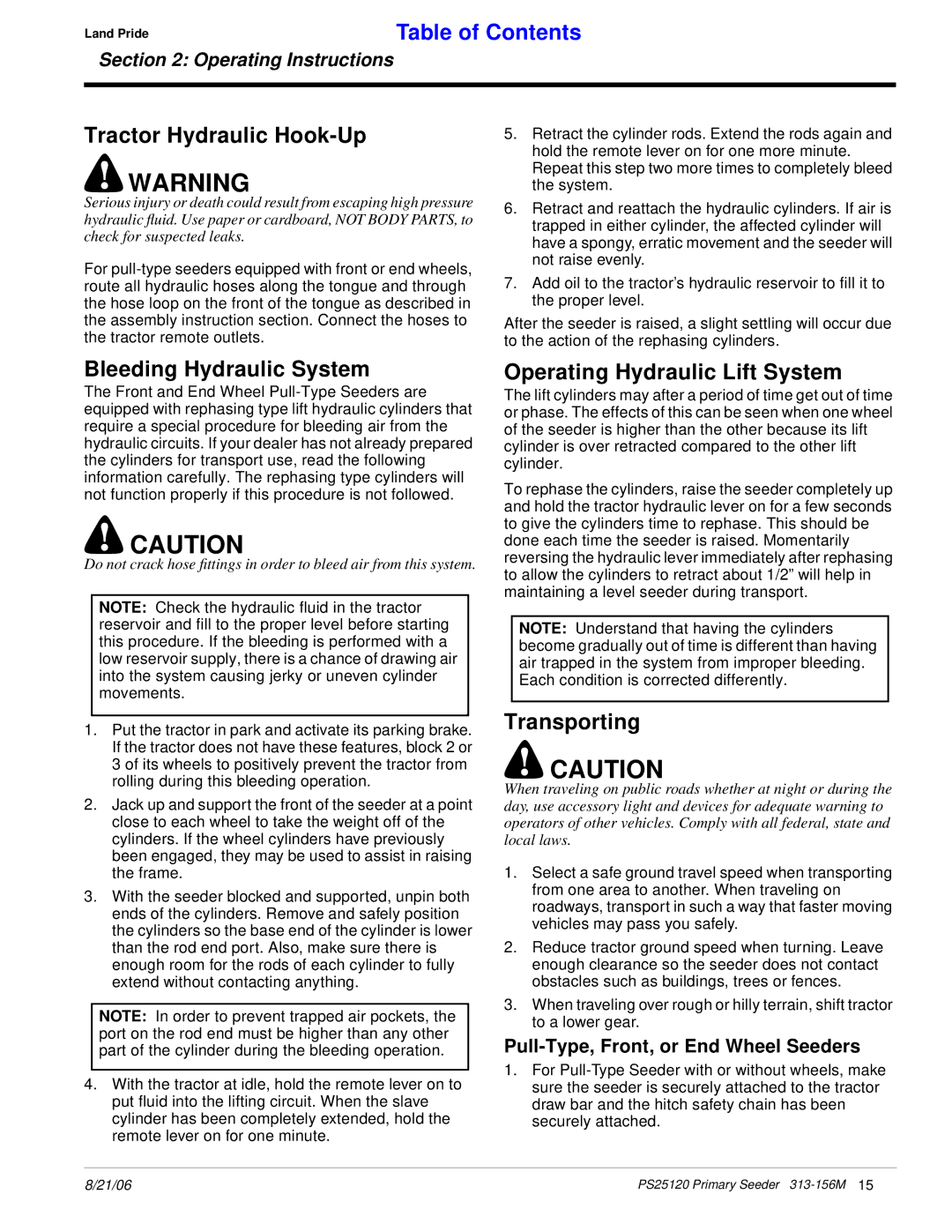
Land Pride | Table of Contents |
Section 2: Operating Instructions
Tractor Hydraulic Hook-Up
!WARNING
Serious injury or death could result from escaping high pressure hydraulic fluid. Use paper or cardboard, NOT BODY PARTS, to check for suspected leaks.
For
5.Retract the cylinder rods. Extend the rods again and hold the remote lever on for one more minute. Repeat this step two more times to completely bleed the system.
6.Retract and reattach the hydraulic cylinders. If air is trapped in either cylinder, the affected cylinder will have a spongy, erratic movement and the seeder will not raise evenly.
7.Add oil to the tractor’s hydraulic reservoir to fill it to the proper level.
After the seeder is raised, a slight settling will occur due to the action of the rephasing cylinders.
Bleeding Hydraulic System
The Front and End Wheel
!CAUTION
Do not crack hose fittings in order to bleed air from this system.
NOTE: Check the hydraulic fluid in the tractor reservoir and fill to the proper level before starting this procedure. If the bleeding is performed with a low reservoir supply, there is a chance of drawing air into the system causing jerky or uneven cylinder movements.
1.Put the tractor in park and activate its parking brake. If the tractor does not have these features, block 2 or 3 of its wheels to positively prevent the tractor from rolling during this bleeding operation.
2.Jack up and support the front of the seeder at a point close to each wheel to take the weight off of the cylinders. If the wheel cylinders have previously been engaged, they may be used to assist in raising the frame.
3.With the seeder blocked and supported, unpin both ends of the cylinders. Remove and safely position the cylinders so the base end of the cylinder is lower than the rod end port. Also, make sure there is enough room for the rods of each cylinder to fully extend without contacting anything.
NOTE: In order to prevent trapped air pockets, the port on the rod end must be higher than any other part of the cylinder during the bleeding operation.
4.With the tractor at idle, hold the remote lever on to put fluid into the lifting circuit. When the slave cylinder has been completely extended, hold the remote lever on for one minute.
Operating Hydraulic Lift System
The lift cylinders may after a period of time get out of time or phase. The effects of this can be seen when one wheel of the seeder is higher than the other because its lift cylinder is over retracted compared to the other lift cylinder.
To rephase the cylinders, raise the seeder completely up and hold the tractor hydraulic lever on for a few seconds to give the cylinders time to rephase. This should be done each time the seeder is raised. Momentarily reversing the hydraulic lever immediately after rephasing to allow the cylinders to retract about 1/2” will help in maintaining a level seeder during transport.
NOTE: Understand that having the cylinders become gradually out of time is different than having air trapped in the system from improper bleeding. Each condition is corrected differently.
Transporting
!CAUTION
When traveling on public roads whether at night or during the day, use accessory light and devices for adequate warning to operators of other vehicles. Comply with all federal, state and local laws.
1.Select a safe ground travel speed when transporting from one area to another. When traveling on roadways, transport in such a way that faster moving vehicles may pass you safely.
2.Reduce tractor ground speed when turning. Leave enough clearance so the seeder does not contact obstacles such as buildings, trees or fences.
3.When traveling over rough or hilly terrain, shift tractor to a lower gear.
Pull-Type, Front, or End Wheel Seeders
1.For
8/21/06 | PS25120 Primary Seeder |
